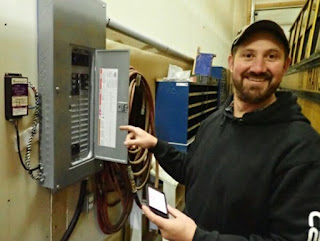Learning Pains of Using Electric School Buses in Alaska
By Jessica Schultz Pleasant
Alaska deployed its first electric school bus in October 2020. It was a collaborative effort between a town in eastern Alaska, Tok in the Tanana Valley, and the Alaska Energy Authority program to provide a $400,000 priced school bus to the local children. When the vehicle is not operating it is charged in a “bus barn”. Solar panels and the local utility company are presently the suppliers of energy to the bus barn.According to Interesting Engineering, the co-owner of Tok Transportation, Gerald “Stretch” Blackard praised the buses performance saying, “it has definitely lived up to expectations.”
Thomas Built Buses advertises the electric school bus being capable of traveling 138 miles (222 km) per charge. Electric batteries do not perform well in cold weather. Electric buses used in Alaska not only work harder on Alaskan snow-covered roads, but also the bus must maintain an inner cabin temperature. This creates a drain on the bus’s battery, cutting battery life in half. There is a higher risk of a bus losing battery life due to the freezing mornings delivering children to school.
Tesla is a leading electric vehicle manufacturer. And describes how temperature impacts the batteries used in vehicles in the Tesla Model S owner’s manual,
“In cold weather, some of the stored energy in the Battery may not be available on your drive because the battery is too cold.” Tesla adds a snowflake icon next to the range indicator to show it might be impacted. Typically, an EV will cover around 20 percent fewer miles in cold weather versus beach weather.”
“When it comes to putting electrons into the battery, freezing weather hurts in two regards. It limits regenerative braking, so the car recoups less power and drivers can't rely on one-pedal driving. And charging, particularly fast charging, will be limited to protect the battery.”
Blackard is experimenting with the difficulties surrounding using electric school buses in Alaska. Blackard discussed how the solar panels are inadequate to maintain the necessary energy for the charging station. He has not fully separated his bus barn from the Alaska energy grid. Alaskan seasons of darkness render solar panels useless. These difficulties are rarely reported by proponents of electric vehicles.
According to Idaho National Laboratory, IDL published results of their study in the July edition of Energy Policy journal, reporting, “[A] new study on charging in cold temperatures suggests that industry and EV drivers still face charging challenges. The reason: cold temperatures impact the electrochemical reactions within the cell, and onboard battery management systems limit the charging rate to avoid damage to the battery.”
There are many factors to account for when experimenting with electric school buses. Alaska sees half a year of darkness and freezing temperatures. Blackard has been collecting data for further research into possibilities to make electric school buses more efficient. Alaska’s experiment with electric school buses is an opportunity to understand how electric vehicles fair in harsh environments. Beyond earthly possibilities, data gathered may even contribute to battery usage in space travel.
The source of energy provided to any vehicle charging point is mostly ran by local natural gas and coal plants. With limited daylight for most of the year, there is no avoiding the use of fossil fuels. To charge a large fleet of buses it would require an unbelievable number of solar panels and acreage to provide only half the year’s energy to charge EVs.
According to Red State, twitter account RNC Reasearch published on February 11, 2023,VP Kamala Harris touted in a tweet the use of chargers for student use at every seat on electric school buses. We are far from capable to provide additional power for electronics used by students. The battery power is already under performing in cold weathers.
According to Tesla, its Tesla Model S reported carbon dioxide from emissions sold through October 2016:
A typical electric car uses about 30 kWh of electricity to charge its battery. The average U.S. household uses about 10,400 kWh of electricity per year. Therefore, charging an electric car uses about one-third the amount of electricity that the average U.S. household uses in a year. To generate this much electricity, about 0.4 short tons (360 kg) of coal is burned. In the United States, about 1.1 billion short tons (1 trillion kg) of coal is burned each year to generate electricity. Therefore, charging an electric car uses about 0.00004% of the coal that is burned in the United States each year.
State regulations requiring the buses to maintain internal cabin temperature is an unavoidable drain on the battery. According to Alaska’s Minimum Standards for Alaska School Buses, 2017 Revised Edition, Section Bus Body and Chassis Specification, A.4., Heating and Air Conditioning System:
“The heating system shall be capable of maintaining the ambient temperature throughout the bus of not less than 45 degrees Fahrenheit during average minimum January temperature as established by the U.S. Department of Commerce, National Weather Service (NOAA), for the area in which the vehicle is to be operated. The inside temperature is to be measured midway back in the bus at shoulder height of seated school children."
"Hypothermia causes multiple dysfunctions, including cardiac arrhythmias,
renal insufficiency, and hemoconcentration. In late stages of hypothermia,
brain function deteriorates, predisposing persons to poor judgment and
increasing their risk for further exposure to excessive cold."
According to the Public Health Post, "Each year in the United States, about 1,330 people die of cold exposure, essentially freezing to death."
"Another concern with EV in Alaska is the water produced from snow melting on roads buses are dropping children off at their homes. During the hurricane batteries within electric vehicles became waterlogged. This caused fires all over the Florida."
According to Fox News, the state's top financial officer and fire marshal, Jimmy Patronis, tweeted:
Tesla is the leading electric vehicle manufacturer. The information the company gathers in developing its cars educates those future manufactures creating their own vehicles. Batteries are an issue across all EVs. According to Tesla, external temperature impacts the batteries used in the Tesla Model S owner’s manual:
“In cold weather, some of the stored energy in the Battery may not be available on your drive because the battery is too cold.” Tesla adds a snowflake icon next to the range indicator to show it might be impacted. Typically, an EV will cover around 20 percent fewer miles in cold weather versus beach weather.”
“When it comes to putting electrons into the battery, freezing weather hurts in two regards. It limits regenerative braking, so the car recoups less power and drivers can't rely on one-pedal driving. And charging, particularly fast charging, will be limited to protect the battery.”
According to Wired, it is recommended to maintain at least 20% of the battery to have enough of a charge to precondition (warm up the vehicle) the EV before driving away. “When it comes to putting electrons into the battery, freezing weather hurts in two regards. It limits regenerative braking, so the car recoups less power and drivers can't rely on one-pedal driving. And charging, particularly fast charging, will be limited to protect the battery.”
According to Idaho National Laboratory, IDL published results of their study in the July edition of Energy Policy journal, reporting:
The transfer to renewable energy is not something to be rushed into. Rushing into an alternative source of energy while at the same time shutting down present energy sources can cause death.While Americans do worry about the future of their children, they must not lose sight of all the good fossil fuels have done to increase life expectancy of people alive today.
Sources:
4. Catenacci, T. (6 OCT 2022). Electric vehicles are exploding from water damage after Hurricane Ian, top Florida official warns. Fox News. Retrieved February 21, 2023. https://www.foxnews.com/politics/electric-vehicles-exploding-water-damage-hurricane-ian-top-florida-official-warns water and batteries in Alaska.
5. Ellis, Tim. (16 NOV 2021). Alaska’s first electric-powered school bus is performing well – even at 40 below. Alaska Public. Retrieved on February 21, 2023. https://alaskapublic.org/2021/11/16/alaskas-first-electric-powered-school-bus-is-performing-well-even-at-40-below/
8. Lewis, M. (19 NOV 2021). Here’s how Alaska’s only electric school bus is performing in temps as low as -40F. Electrek. Retrieved on Feb 21, 2023. https://electrek.co/2021/11/19/heres-how-alaskas-only-electric-school-bus-is-performing-in-temps-as-low-as-40f/#:~:text=Alaska%E2%80%99s%20electric%20school%20bus%20in%20the%20extreme%20cold,Authority%20program%20covered%20the%20rest%20of%20the%20cost.
Bonchie. (11 FEB 2023). Kamala Harris Gets Uncomfortably Excited About Electric School Buses. Red State. Retrieved on February 23, 2023. https://redstate.com/bonchie/2023/02/11/kamala-harris-gets-uncomfortably-excited-about-electric-school-buses-n702207
10. Smith, Rob. (5 MAR 2018). The surprising truth behind the world's electric cars. World Economic Forum. Retrieved February 21, 2023. https://www.weforum.org/agenda/2018/03/electric-cars-are-still-coal-powered/





Comments
Post a Comment